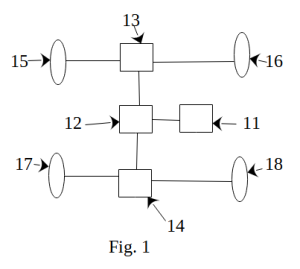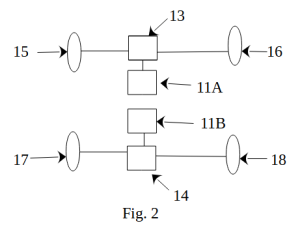 Many owners of an all-wheel-drive vehicle have had it drummed into their heads that if you find the need to replace one tire, the only correct way to proceed is to replace all four tires. But if your vehicle is a “dual motor” EV, that’s wrong. You can get away with replacing just two tires.
Many owners of an all-wheel-drive vehicle have had it drummed into their heads that if you find the need to replace one tire, the only correct way to proceed is to replace all four tires. But if your vehicle is a “dual motor” EV, that’s wrong. You can get away with replacing just two tires.

Figure 1 shows, in schematic form, the drive train of an ICE (internal combustion engine) all-wheel-drive vehicle. ICE engine 11 delivers torque to a differential 12, which splits up the power and sends part of the power to the front of the vehicle (toward differential 13), and sends the rest of the power to the rear of the vehicle (toward differential 14). In the front of the vehicle, differential 13 splits up the power and sends part of the power to the left front wheel 15, and sends the rest of the power to the right front wheel 16. In the rear of the vehicle, differential 14 splits up the power and sends part of the power to the left rear wheel 17, and sends the rest of the power to the right rear wheel 18.
Now we need to talk a little bit about differentials (Wikipedia article). A differential is a clever mechanical device that uses gears to enable one shaft to rotate at a rate that is exactly the average of the rotational rates of two other shafts. The first documented differential was in the Antikythera mechanism (Wikipedia article), an ancient Greek hand-powered orrery dating from at least as long ago as 87 BC. In a vehicle, a differential is extremely important because it enables two wheels to rotate at slightly different rates, for example when the vehicle is making a turn.
A key thing about differentials is that you can “burn them up”. With most differentials, including those used in vehicles, the function of “enabling one wheel to rotate at a different rate than another wheel” is a function that must be used sparingly. The gears that enable this function are small and they get worn down with use. Those gears are on bearings that can get worn out.
If the vehicle is only turning every now and then, and if the vehicle is usually driving straight ahead, then the gears just mentioned will last the life of the vehicle. But if, for example, the tire of wheel 15 were to have a notably different diameter than the tire of wheel 16, this would force the gears that enable this function in differential 13 to operate continuously. They would get burned up. This explains why, in the vehicle of Figure 1, the owner cannot merely replace, say, the tire of wheel 15. The owner must also replace the tire of wheel 16. (The possible exception to this might be if both tires are nearly brand new and if this can enable the replacement tire of wheel 15 to be a very close match in diameter to the tire of wheel 16.)
In the vehicle of Figure 1, it is important to consider that the mechanical component 12 is also a differential. This means that if the owner replaces, say, the tire of wheel 15, then its diameter will be non-identical to the diameter of the tires of wheels 17 and 18. This will force the differential gears and bearings in differential 12 to operate continuously, and they will get burned up.
 Now we turn to Figure 2, which shows in schematic form the drive trains (plural) in a typical dual-motor EV. Front motor 11A drives a front differential 13, which in turn delivers power to front wheels 15 and 16. Rear motor 11B drives a rear differential 14, which in turn delivers power to rear wheels 17 and 18. The motors 11A and 11B are each powered electrically and there is nothing about the way the vehicle operates that requires motors 11A and 11B to rotate at exactly identical rates. One of the motors could go slightly faster or slower than the other and this would not cause any problem in any aspect of the operation of the drive trains.
Now we turn to Figure 2, which shows in schematic form the drive trains (plural) in a typical dual-motor EV. Front motor 11A drives a front differential 13, which in turn delivers power to front wheels 15 and 16. Rear motor 11B drives a rear differential 14, which in turn delivers power to rear wheels 17 and 18. The motors 11A and 11B are each powered electrically and there is nothing about the way the vehicle operates that requires motors 11A and 11B to rotate at exactly identical rates. One of the motors could go slightly faster or slower than the other and this would not cause any problem in any aspect of the operation of the drive trains.
The alert reader will already have figured out where I am going with this. If the owner of the vehicle finds some reason to replace, say, the tire of wheel 15, then the only “burning up” opportunity is with differential 13. A mismatch of diameters between, say, the tires of wheels 15 and 18 does not present any “burning up” opportunity at all because there is no differential (or any other mechanical linkage) connected to both of those tires.
It means that if the owner finds the need to replace, say, the tire of wheel 15, then the other other tire that could possibly need to be replaced at the same time is the tire of wheel 16. (And if both tires were brand new and placed into service very recently, maybe the owner could forgo the replacement of the tire of wheel 16.)
I am embarrassed to report that I figured this out only after replacing all four tires on my dual-motor EV (after one tire had a sidewall puncture).
Many readers of this blog probably already knew all about this. For them, this blog is only telling them what they already knew. But I offer these thoughts in case it might save some readers a bunch of money for an otherwise unnecessary couple of replacement tires.
Even on a non-4-wheel drive car, I suppose the differential problem means you should never replace only one of the driven tires at a time, although the non-driven tires can be replaced individually.
Thank you for commenting. Yes I think that is correct.
An alternative approach is to order a single new tire from tirerack.com and have them reduce the diameter of the new tire to match the diameter of the old tires. I’m not sure what technology they use to accomplish that result.